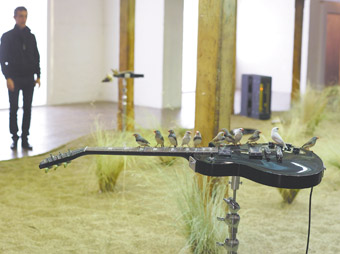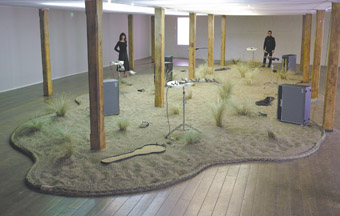of the moment and about time!
andrew harper: mona foma festival of music & art, hobart

Céleste Boursier-Mougenot, From Here to Ear (2009), mixed media, Long Gallery, Hobart,
photo Peter Whyte, with thanks to Galerie Xippas, Paris
Céleste Boursier-Mougenot, From Here to Ear (2009), mixed media, Long Gallery, Hobart,
MONA FOMA ARRIVED QUICKLY IN HOBART, GESTATING AND HATCHING IN A VERY SHORT PERIOD. THERE WAS AN ODD MARKETING CAMPAIGN AND THEN IT WAS UPON US, ON THE STREET AND EVEN IN THE LETTERS COLUMN OF THE MERCURY, AS PEOPLE COMPLAINED AND PONTIFICATED ABOUT FUNDING AND TIMING. THE DAMN THING WAS EVERYWHERE.
MONA FOMA was something different. The convoluted acronym translates as: Museum of Old and New Art Festival of Music and Art. MONA is not yet open but when its mastermind David Walsh went public with the idea last year, the arts landscape in Tasmania changed dramatically—word spread of a collection of apparently incredible stuff in a unique museum that would be free for all to see.
Violent Femmes member Brian Ritchie emerged as festival curator, backed by the Salamanca Arts Centre. Suddenly an event was looming. The whole thing fell from the sky and Hobart was dazed and confused, which appeared to be the idea.
The festival opened with a huge free night-time show in Salamanca Place. Performances on a stage in a blocked off street, opera sketches by IHOS, aggressive, violent contemporary dance by Balletlab and a whole lot of art to see drew in a huge crowd. People voted with their feet, and given that it was all free (well, except for Nick Cave) that was easy to do.
The festival was fun and exciting and more than that, it felt like something we really need in Hobart—a big, bright, sprawling festival that isn’t about The Wilderness or Local Produce and doesn’t primarily feature nice music to have a pinot to. Instead we got art that wowed, charmed and seduced and the city loved it.

Céleste Boursier-Mougenot, From Here to Ear (2009), mixed media, Long Gallery, Hobart
photo Peter Whyte, with thanks to Galerie Xippas, Paris
Céleste Boursier-Mougenot, From Here to Ear (2009), mixed media, Long Gallery, Hobart
It was the content that did it. Hype and controversy made people curious but this would have backfired had the work not been so engaging, and exhibited so differently. The Roaming District Church, a mobile work by Jensen Tjhung, appeared and disappeared around the city. Its weatherboard exterior, polished interior and the calming psychedelic loops that oozed from the speakers evoked memory and a sense of time somehow; but if there’s something that music is truly about, then it probably is time—each beat and bar measures time passing. This thought became something of a theme for all the work for me. The little church was very evocative.
Time, again, was investigated by Manon De Boer’s short film Two Times 4’33”. Yes, it was the John Cage work and, yes, it’s about the other sounds that take place when a piano is not being played, and indeed the impossibility of silence. And we knew that, but the film took the ideas somewhere else by letting us watch the bars of no playing being read, and then for the second run through, a pan of the intent audience swiftly brought the experience back to oneself, sitting in a specially constructed screening room at the Tasmanian Museum and Art Gallery that had instructions for entry: not when the red light is on, thank you. Time and sound were pulled apart in very strict fashion.
The Long Gallery at the Salamanca Arts Centre was transformed entirely by the insertion of walls, headphones and a special room. The headphones contained a selection from the exciting 21:100:100 Sound Art exhibition from Gertrude Contemporary Art Spaces in Melbourne last year—by all accounts a truly thrilling exhibition, firmly stating the important place sound art has in Australia and the world (RT 88, p43). It’s such a wonderful installation—half the fun is watching people stoop and perch to listen, becoming monks for a moment.
In the Sidespace, just off the Long Gallery, Raef Sawford combined tiny screens on black plinths, an electronic rendition of Greensleeves and a fluttering projection around the darkened room into a work that wore time on its sleeve, entitled In Search of Lost Time. This work seemed to want to be larger and more all encompassing than allowed to be by the space, but the spread of darkness and its punctuation by differing use of light was neatly done.
Scot Cotterell’s work over in Kelly’s Garden, was a stark contrast, largely because it was rather funny. He combined black plastic, mirror balls, sludge metal sounds oozing from a 2001 style edifice and a joyously tasteless garden fountain spluttering Coca-Cola. The fountain was a lurid pink and the installation a monument to the awful glory of consumer crap everywhere.
Back in the Long Gallery there was a room within a room. Here was the centerpiece of MONA FOMA—From Here to Ear by Céleste Boursier-Mougenot. It featured 35 live zebra finches hopping about on cleverly tuned Les Paul guitars placed horizontally on stands for easy perching, scattered in an environment of sand and wild grasses. The guitars had amplification and even a little distortion, and as one moved about the room and the birds reacted, sound emerged. It was hypnotic and seductive to a high degree—this was the work Hobart really did fall in love with. People returned again and again to experience the fragile, beautiful creatures, colourful and fleeting like the perfect dream of a rock star. It was gorgeous.
The work that held me most, though, was outside: Cameron Robbins’ Marine Test Rig perched on the edge of the harbour. A little wooden cabinet containing pipes that stretched down into the river, it made sound as the motion of the water pushed air up into the cleverly constructed pipes. It hooted and blew with the imprecise rhythms of the sea, and it crept up on me-—what it was, how it worked and what it said about nature and time. The small music-making hut was all by itself, the sea playing it whether anyone was there or not. The motion of air and water came together and as my hair ruffled, I heard music that really was time and tide.
MONA FOMA Festival of Music and Art, curator Brian Ritchie, Museum of Old and New Art in conjunction with All Tomorrow’s Parties, Salamanca Arts Centre, Tasmanian Museum & Art Gallery, Hobart, Jan 9-12
RealTime issue #89 Feb-March 2009 pg. 42






